
![]()
![]()
|
Goals.--Following the success of our 1994 "proof of concept"
award (see 1994
NSF Project Report), and Years One and Two of the present grant
(see 1995
and 1996
NSF Annual Reports), the primary goal of this fourth of six expeditions
to the Kuril Archipelago was to continue our survey northward to five islands
that make up the northernmost part of the chain: Paramushir,
Makanrushi,
Shumshu,
Alaid
(Atlasova), and Antsiferova
(see Map-based
locality record browser). We also planned to return to a number
of previously under-collected localities on central and southern islands
visited in previous years [i.e., Brat
Chirpoev, Lovushki,
Urup,
Ushishir
(Ryponkicha and Yankicha), Iturup,
and Kunashir].
Reflecting a change in the scope of the project, approved by NSF in January
1996, we determined to redirect efforts and resources toward invertebrates
(primarily terrestrial insects) at the expense of birds and mammals (see
Island
Info). In every way these goals were met.
 Results to date.--An international team of 28 students and
scientists--13
on the Russian Team, five on the Japanese Team, and 10 on the American
Team (see Project Participants, 1997
Expedition)-met in Vladivostok, Russia, on 21 July 1997, boarded
the 68.8-m Professor Bogorov, a research
vessel of the Russian Academy of Sciences, and spent 28 days in
the field (considerably fewer than the 33 days logged last year and 42
days logged the year before due to unusually bad weather--by far the worst
we have ever experienced in the Archipelago).
Five islands of the northern Kurils, five from the central Kurils, and
two from the southern group were visited, as well as the mainland of the
Russian peninsula of Kamchatka. Collections were made at 1,311 sites (see
IKIP
Databases)--somewhat more than the 1,167 sites collected in 1995 and
1,142 in 1996, despite fewer days in the field and the bad weather: Paramushir
477, Shumshu
302, Kamchatka 12, Alaid
(Atlasova) 84, Antsiferova
26, Makanrushi
105, Lovushki
5, Ushishir
82 (Ryponkicha 43, Yankicha 39), Brat
Chirpoev 48, Urup
2, IturupIturup
116, and Kunashir
52 (see Map-based
locality record browser)--in widely varying habitats, similar to
those collected in previous years (see Macro-
and microhabitats of the Kuril Islands): from sea-level sandy-,
rocky-beach, and grassland to high-mountain stream/conifer forest; from
deep, slow-moving lowland rivers to fast-flowing gravelly streams; and
from sphagnum bogs to high mountain lakes.
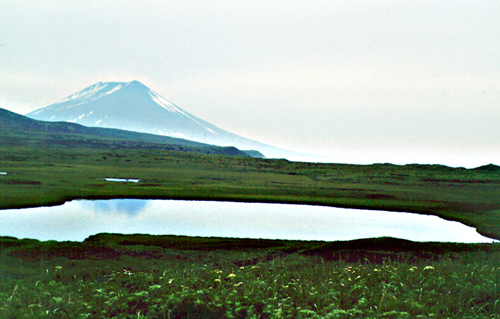 Collecting was confined primarily to vascular plants, aquatic and
terrestrial
insects, spiders and harvesters, freshwater and terrestrial mollusks,
freshwater
and anadromous fishes, amphibians, and reptiles (smaller collections of
fungi, lichens, mosses, liverworts, diatoms, pseudoscorpions, mites,
decapods,
water fleas, centipedes, millipedes, marine fishes, and marine mammals
were also made). In addition to bad weather (significantly worse than we've
experienced in the past), certain uncontrollable difficulties inherent
in the project repeated themselves this year (such as impenetrable vegetation
making adherence to transects impossible and difficult shore landings at
some sites). However, the problems we experienced in 1994 of gaining access
to certain islands and to sites within islands did not reoccur. Our research
vessel, the 68.8-m Professor Bogorov, which also served as our
base
of operations in 1994 and 1995 (the 75-m Akademik Oparin was used in
1996),
was very comfortable and ably managed by its Russian crew of 32 (see
Russian
Research Vessels).
Research products.--Although counts are still preliminary--and
despite the considerably less diverse biotas of the northernmost islands
and fewer days in the field (compared to last year)--approximately 53,155
specimens were successfully exported to the U.S. (compared to 63,700
specimens
exported in 1996):
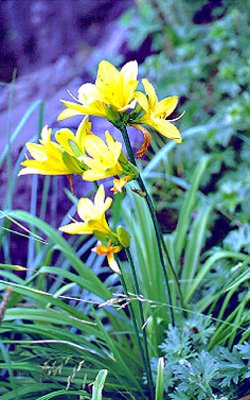 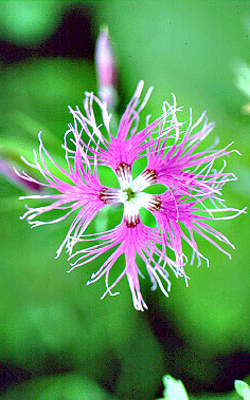 Plants: about 3,200 specimens of vascular plants, representing
52 families and approximately 310 species, plus 700 specimens of lichens
(included here among plants for convenience only), and 540 bryophytes and
hepatophytes (mosses and liverworts), for a grand total of approximately
4,400 specimens; two or three lichen and bryophyte taxa appear to be new
to science; about 360 new records of vascular plants for various islands
(for which plant collections have not been reported previously) and, among
lichens and bryophytes, at least ten new records for the Archipelago.
Aquatic insects: 5,248 specimens, representing 22 families and a
minimum of 97 species, of which 18 represent new records for various
islands and six represent new records for the Archipelago. Terrestrial
Insects: about 27,065 specimens, representing 17 orders, about 90
families, and perhaps as many as 650 species; the material undoubtedly
includes new taxa and many new records, but less than half the collection
has been sorted to species and much is not yet even sorted to family. (See
IKIP
Insect Report for a comprehensive report on the research results for
both aquatic and terrestrial insect groups.) Spiders
and harvesters: 7,008 specimens, representing 20 families and
151 species, of which at least 10 are thought to be new to science; at
least 75 species represent new records for various islands (prior to last
summer,
spiders had never been reported from five of the islands visited in 1997:
Ryponkicha, Lovushki, Antsiferova, Makanrushi, and Brat Chirpoyev), and at
least 35 species are new to the Archipelago (but much of the material
remains to be sorted and identified, and some that is sorted is identified
only to genus). Mollusks: 6,520 specimens, representing 16 families
and a minimum of 21 species, of which at least two species appear to be
new to science, and of which 48 represent new species records for various
islands and two represent new species records for the Archipelago.
Freshwater fishes: 1,980 specimens, four families, and 11
species. Marine fishes: 620 specimens, seven families, and 23
species, of which one represents a new record for the Archipelago.
Amphibians and reptiles: 44 specimens, three families, and three
species.  The plants, spiders and harvesters, and fishes are presently being
identified and cataloged here at the University of Washington in the Department of
Botany, Burke
Museum, and School of Aquatic and
Fishery Sciences,
respectively. The majority of the insects are being curated at the Department of
Entomology, California Academy of Sciences, but certain groups, e.g., the
aquatic and hymenopteran taxa, are being housed here in the Fish Collection
for study and management by IKIP entomologists Noboru Minakawa and Brian Urbain. The mollusks are
being processed at the Delaware Museum of Natural History, by Tim
Pearce, but are eventually destined to join previously collected and
cataloged IKIP material at the Museum of
Zoology, University of Michigan, Ann Arbor. Curatorial work on the
mollusks and vertebrates is well in hand, but much remains to be done with
the plants and other invertebrates. 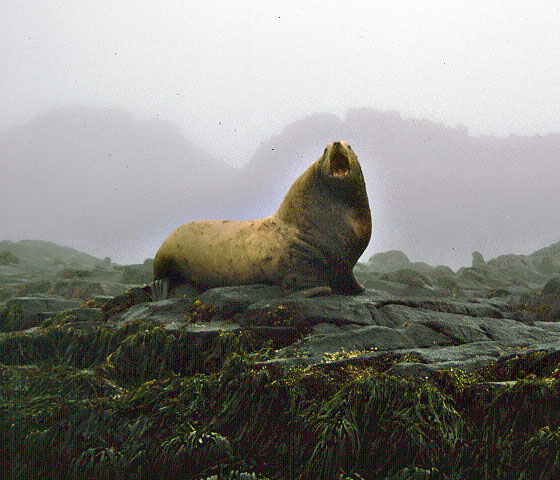 Considerable time and effort has gone toward creating, maintaining,
and updating an IKIP web-site, the heart of which is our search gateway
to IKIP
Databases: (1) Forms-based
database search gateway, (2) Map-based
locality record browser, and (3) Loans
and Gifts of IKIP material (please note that our IKIP web-site
was developed without the use of NSF funds). Since our return from the
Kurils in September 1997, we have been working hard to make all our data
available electronically, but dealing with tens of thousands of specimens,
it has been a major undertaking. All of our 1994, 1995, 1996, and 1997
locality data are on-line (4,191 sites on 26
islands) and we have entered in excess of 5,100 taxonomic records. To date,
all of the following have been identified, cataloged, and made available
on the web-site: all Hemiptera, Plecoptera, Trichoptera, Neuroptera,
Dermaptera,
aquatic and carabid Coleoptera, spiders, mollusks, and fishes from the
1994 expedition; all plants, Ephemeroptera, Heteroptera, Plecoptera,
Trichoptera,
Neuroptera, Dermaptera, Psocoptera, aquatic beetles, mollusks, and fishes
from the 1995 expedition; all Heteroptera, Plecoptera, silphid
Coleoptera, and fishes from the 1996 expedition; and all fishes from the
1997 expedition.
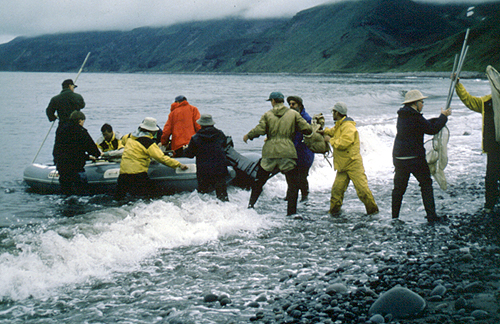 Human resource development.--Two University of Washington
undergraduates,
Birgit
Semsrott (plants) and Todd
Ritchie (insects) (both supported by REU funds, see below), and
two UW graduate students, Noboru
Minakawa (aquatic insects) and Duane
Stevenson (fishes), all full participants in the 1997 expedition,
received training in field work, curatorial practices, and systematics
within their areas of interest. Their experience continues here at home
as collections are being sorted and identified, and publications prepared.
We've also provided curatorial training and experience to a number of
unpaid volunteers at the Burke
Museum. The most production of these individuals has been Janet
Wall who has been immensely valuable to us in working with IKIP spiders.
From May 1996 through December 1997, Janet donated 476.5 hours of her time.
Her work included the massive job of double-checking, plotting, and
correcting
all the field locality data for all spiders collected in 1995 and 1996
(approximately 12,200 specimens). During curation of the 1995 specimens,
she was responsible for cutting, washing, and inserting the final labels
into vials, filling and stoppering the vials, and arranging and integrating
the material with the 1994 collections. She was also responsible for
selecting
a portion of the 1995 specimens that could be "spared" for transfer as
a gift to the California Academy of Sciences. In addition, Janet did the
majority of the data entry required to make the 1995 spider data available
on the IKIP web-site.
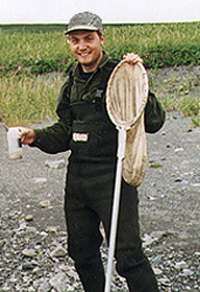 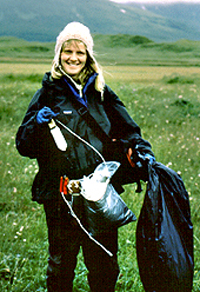 Research Experiences for Undergraduates supplemental support received
in 1997 was well used. One of the two recipients, Todd
Ritchie, assisted in the collection of approximately 32,300 insects
(5,250 aquatic and 27,050 terrestrial), which he helped to sort, label,
and identify to order, much of the work accomplished while still aboard
the research vessel. He was responsible also for key-boarding all of our
1997 locality data, a huge task that was accomplished with very few errors.
Overall, the experience had a profound effect on him: "By documenting
detailed
observations of microhabitats of species, I began to understand the
complexities
of aquatic-terrestrial interactions and of biodiversity in general. I now
have a real appreciation for the diversity, beauty, and significance of
insects! But, the most rewarding aspect of participation in IKIP, was the
experience of working and living with scientists from Russia, Japan, and
the United States, and the camaraderie attained through a common interest
in the preservation of biodiversity." Todd has not decided on an area of
specialty, but he appears to be on his way toward becoming a professional
zoologist.
Birgit
Semsrott, the second recipient of 1997 REU support (and a veteran
of our 1996 expedition), assisted in the collecting, sorting, drying, and
identification of plants during IKIP-1997, helping to bring back a total
of about 4,440 specimens (more than 1,900 of which she collected on her
own). Her proficiency in field identification improved steadily this
year--she
has become especially skilled in her ability to recognize and collect
lichens.
Her extensive and accurate field observations made on fresh material have
proved to be critical in subsequent identification. She also photographed
many plants in the field--we feel certain that, between the two botanists
associated with the project, we now have by far the most complete
photographic
record of Kuril Island plants in existence. In addition, Birgit has given
several botanical seminars based on her Kuril Island experience, one for
the Seattle Lichen Guild and another for the UW Undergraduate Botany Club.
She was also recently featured in the UW Botany Department alumni newsletter:
"Botany Undergraduate Finds Adventure in the Kuril Islands," Newsletter
of the Department of Botany, University of Washington, 1(1):4-5, January
1997. Although not a co-author, Birgit assisted in preparing a "Flora of
Chirpoi," published by IKIP botanists in August 1997 (Acta Phytotaxonomica
et Geobotanica, 48:31-42). Her contributions to IKIP botanical work
will find outlet in the coming year as co-author on papers concerning the
floras of Raikoke, Ekarma, Kharimkotan, and Chirinkotan. Birgit is now
a graduate student at Humboldt State University, where she is working on
insect-plant interactions (pollination ecology) and serving as a teaching
assistant in "Plant Systematics."
 Loans and gifts.--We have worked hard to make our material
available
to the international scientific community through loans
and gifts of specimens. To date, we have made 62 loans and gifts
(whole specimens as well as tissues fixed in ethanol) to 54 specialists
around the world, totalling 2,540 lots and 30,577 specimens.
Seminars and media attention.--We have made a concerted effort
to inform academic as well as public audiences about IKIP through oral
presentation, and have received considerable attention
from the media in return. To date, veterans of IKIP have presented
more than two dozen scientific talks and have been the subject of more
than a dozen articles in newspapers and magazines. The 1996 expedition
was recorded in full by three employees of the Hokkaido
Television Broadcasting Co. (Yasumasa Shinomiya, writer; Osamura
Hidetoshi, photographer; and Nikolai Shapotin, interpreter), resulting
in a 30-minute television production that was aired in Japan on 2 March
1997. A 90-minute show on the people and general natural history of the
Kuril Islands, which aired in April 1997, also featured IKIP-1996. Copies
of these videos were made available to NSF last spring. The 1997 expedition
was recorded in full by South Korean Television, Soo Yong Park, Producer,
but we have not yet received copies of the video.
Highlights of the 1997 Expedition quoted in the media include:
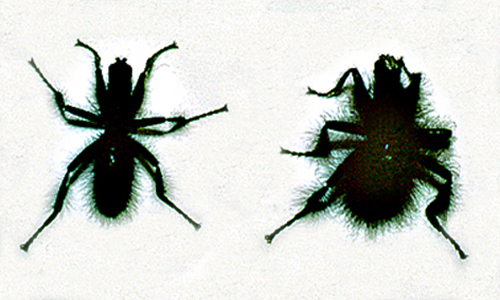

"Sound bites" reported last year, of some of the more exciting discoveries
to date, are still being quoted by the media:
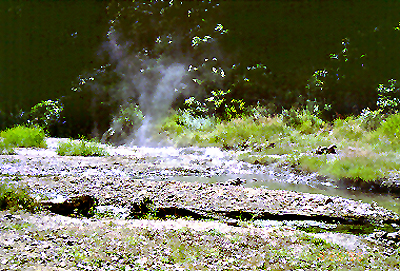 species of fish, a goby of the genus Chaenogobius
Publications.--Thirty-eight papers
have now been published. An additional seven are in press, another five
have been submitted, and about 20 are at various stages of preparation.
Thirty-two descriptions of new taxa have been published or are currently
in press or submitted for publication: six new species of caddisflies
(Trichoptera:
Hydroptilidae, Leptoceridae), one new stonefly (Plecoptera:
Perlodidae), one new beetle (Coleoptera:
Carabidae), three new flies (Diptera:
Scathophagidae, Syrphidae), one new bug (Hemiptera:
Miridae), 10 new parasitic wasps (Hymenoptera:
Braconidae), four new freshwater bivalves (Bivalvia: Unionidae, Anodontidae),
five new terrestrial and freshwater gastropods (Gastropoda: Planorbidae,
Valvatidae), and one new fish
(Teleostei: Osmeridae). Among our larger publication efforts is Y. N. Zhuravlev
and A. S. Kolyada's book on the biology of ginseng published in 1996:
Araliaceae:
Ginseng and Other Aralia of the Russian Far East,
Dalnauka,
Vladivostok, 280 pp., 41 black and white figures, 8 color plates, 11 tables,
and 859 bibliographic references. That portion of the book that covers
Kuril Island species was funded in part by DEB-9400821 and DEB-9505031;
NSF is properly acknowledged
on page 1 of the front matter.
Our second larger publication effort, for which we received supplemental
support from NSF, is an English translation of G. O. Kryvolutskaja's
Entomofauna
of the Kuril Islands, originally published in 1973 by the
Institute
of Biology and Soil Sciences, Far-Eastern Scientific Center, Russian Academy
of Science, which is being edited, augmented, illustrated in color, and
made available electronically. The book has now been completely translated
by Elliott B. Urdang, M.D., M.A. (in Russian), of Providence, Rhode Island,
and all parts have been delivered to us by diskette and hard-copy: the
Abstract,
Preface,
and Table
of Contents (5 pages), Chapter
1, "History of investigations of the insect fauna of the Kuril
Islands" (7 pages); Chapter 2, "General information on the insects of the
Kuril Islands" (8 pages); Chapter 3, "Accounts of insect taxa of the Kuril
Islands" (including methods and materials, keys, descriptions, and general
taxonomic accounts by order; 130 pages); Chapter 4, "Ecological and
geographic
review of the Kuril Island entomofauna" (including physical conditions
of the Kuril Islands, ecological features of the Kuril Islands, and insect
assemblages and primary habitats of the Kuril Islands; 82 pages); Chapter
5, "Speciation on the Kuril Islands" (10 pages), Chapter 6, "Zoogeography
of the Kuril Island entomofauna" (including geological history and floral
evolution, zoogeographic origins and trends, and subdivision of the Kuril
Archipelago based on insect distributions; 28 pages); Conclusion
(4 pages); Summary
(2 pages); Literature cited (15 pages), Index of scientific names of insects
(19 pages); List of scientific and Russian names of plants (2 pages); all
the tables (22); and the legends to all the figures (67). The Abstract,
Preface, Chapter 1, Conclusions, and Summary have now been edited and are
available on the web-site. Work on the remaining chapters is in progress.
Similar plans to publish electronically V. Y. Barkalov's Plants of
the Kuril Islands, are currently on hold while we await delivery of
the manuscript. Although promised to us back in June 1997, his approximately
650-page work is still not finished.
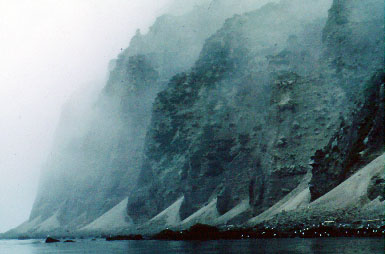 Plans for summer 1998.--We are now in preparation for the coming
summer expedition (approximately 15 July--8 September 1998), during which
time we will return to the southernmost
islands of the chain: Kunashir,
Iturup,
Shikotan,
and the isles of the Habomai Group. Although we made large collections
on four of the southern islands in 1994, only 31 actual field days were
available to us, many of the numerous available habitats were inadequately
surveyed, and major taxa were not collected (e.g., plants and terrestrial
insects); it is thus crucial that we go back to these islands, the most
biologically diverse of the chain (see Map-based
locality record browser).
Thank you for the generous support we have received. We hope this brief
report meets with your satisfaction.
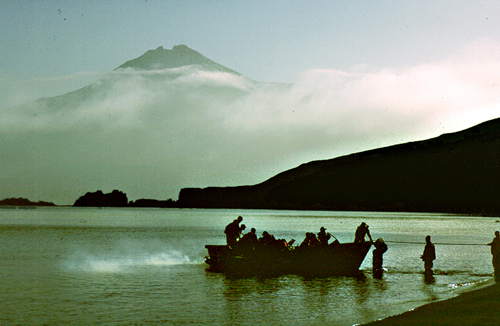 |
![]()